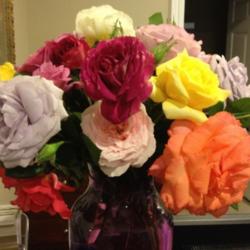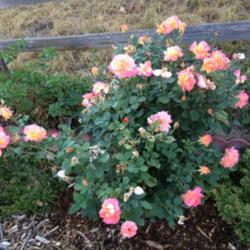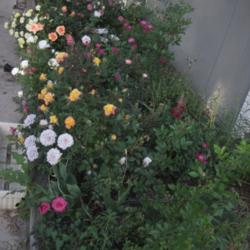The Society of American Florists says Valentine's Day is the top holiday for sales of fresh flowers, with nearly 200 million roses sold on the holiday in 2012! So what makes most people afraid of growing them? "Oh, they're too hard." "I don't have time to dedicate to something so fragile!" "Oh, they won't grow here!" "I've tried and I just can't get them to grow!" Well, what I'm going to say is that I've heard it all and I can tell you: "Yes, you can grow roses!"
Growing roses isn't hard. I've found in my experience that growing roses is much easier than growing grass. Now granted, I don't think anyone wants to run barefoot over a field of roses as you could over grass, but at the same time, taking a magnificent bouquet of home-grown roses into your workplace every single week will generate massive amounts of envy from your co-workers. This I know!
 |
Almost all summer and fall, I bring them to my workplace and my co-workers breathe in deeply of the luscious scents that the blooms offer. If it's a particularly beautiful rose, I'll keep it after the bouquet starts to wilt, put the bloom on its side behind my printer, and voila! I have a wonderfully dried rose! Considering my particular difficulties in growing almost anything in the Denver, Colorado area, if I can grow roses, ANYONE can grow them.
There's no special "trick" to growing roses. You just have to know your landscape, know your weather, and know what you're willing to do.
 |
You can have an entire yard dedicated to roses and shrubs, or you can just have a single blooming machine: a climbing "house eater" like Yellow Lady Banks; a one-time bloomer that goes on for weeks like Charles de Mills, the stereotypical "florist" rose like Kordes' Perfecta, the exotic color of Blue Bajou, or the unique form of Topsy Turvy. There are roses for any type of taste, preference, environment, everything.
 |
 |
 |
 |
Top left and clockwise: Charles de Mills, Kordes' Perfecta, Topsy Turvy and Blue Bajou
I live in an area that is zone 5a/5b. There are times (for instance, in April 2006) when I've seen the temperature actually fluctuate from a high of 81 to a low of -17 in a single 24-hour period. Granted, almost everything died in that situation, but that's because I wasn't prepared (and didn't have any roses either). But with our wild weather here, extreme altitude (more than 6,000 feet above sea level), extremely dry conditions (average humidity is usually 12-18% during the day and 20-25% at night in the summer), cold/hot winters (on Saturday, October 13th, the high was 48 degrees and on Monday, October 15th, the high was 81 degrees), early snows (we usually see the first snow or heavy frost in September), late winters (the first "safe" day of planting is Mother's Day), and short growing period (usually May 10th through September 10th), growing anything but weeds can be a major chore. Now if only my roses grew as well as the weeds do, I'd be set for life! With a little perseverance, however, not only do I grow roses, but I grow over 300 different ones in my yard.
I don't do anything special to the soil and I don't use any special fertilizers (MiracleGro in spring and ‘Age Old’ products in late summer). I water with a hose, using city water with all of the nasty chemicals that cities use for purification, and I still have roses. So if I can grow them, anyone can!
I cannot speak for people who live in warm environments, have high humidity, or have major bug problems (luckily, I don't have Japanese rose beetles or slugs or many of the other banes that plague rosarians) or even critters that eat them (no deer, gophers, or moles). What I do have is rock-hard clay on top of drifting sand, no rain, and desiccating winds. This is how I grow my zone 6-7 roses that come back for me year after year, such as Mardi Gras, the first rose that I planted back in 2008.
 |
Mardi Gras
First I have to figure out what kind of rose it is. Is it a hybrid tea? Is it a shrub rose? Will it grow tall? Will it be leggy or bushy? Will it become a house-eater? After I figure out what kind of rose it is, what color are the blooms? I don't want to stick a bright orange rose like Kordes' Brillant next to a medium-pink one like Duftrausch; this will look tacky. Something has to be between them so that they don't clash that badly. I like bright and gaudy, but putting roses like those together needs to have a little thought behind it.
 |
 |
Kordes' Brillant and Duftrausch
Or maybe you want to build an area with an underlying "theme." With as many different roses as there are, you can build an area or bed with just a single color scheme (red, pink, yellow, or mauve) or a name theme (Politicians like Mister Lincoln or celebrities like Barbra Streisand). There are even roses named after fairytales or princesses (Princesse de Monaco). The choice is yours! One particular bed I'm currently developing is a patriotic bed with "blue" roses on the outside edge, red roses in the middle, and a single huge white rose in the center. Just a good ol' USA thing going on.
 |
 |
 |
Mister Lincoln, Barbra Streisand and Princesse de Monaco
The big thing with roses is their roots. Most plants have roots, and plants need their roots to be taken care of.
 |
Roses come in two types as far as roots are concerned: own-root roses and grafted roses.
The roses of the first group are called "own-root" because the rose plant was grown from a cutting and developed its own root system. This means that if the plant dies down to the ground during the winter, you don’t have to worry because it probably will come back as long as the roots are alive. Own-root roses usually are smaller plants in the beginning, but I have had great luck with them because they will, if they're planted correctly and taken care of properly their first year, come back true year after year. Own-root roses usually are able to withstand colder temperatures as well, so they often are marketed for colder zones.
As for grafted roses, one of the things we talk about here in the ATP Rose Forum is "bodybag roses".
 |
These are roses that are sold in plastic bags with their canes sticking out of the top. They usually are the very first roses that are available in spring in the big box stores and nurseries. This is my personal opinion, but I would advise you to RESIST BUYING THESE ROSES. I have tried to grow them for years to no avail. I'm not saying that it cannot be done, but the poor roses are pruned to within an inch of their lives, with their roots chopped off almost 100%. The bags usually are 10-12 inches long and a nice fat 3-5 inches thick. DO NOT BE FOOLED. When you actually open the bag, you will find 2-4 inches of roots and the rest all sawdust.
 |
 |
PLEASE DO NOT BUY THIS TYPE OF ROSE!
In addition, I'd bet that 90% of the roses you're going to see for sale in “body bags” and the roses sold in containers ranging from 2-gallon to 5-gallon buckets at nurseries and the big box stores are grafted roses.
 |
 |
The root systems on these roses usually are a toss up. I've seen beautiful root systems on container roses, and I've seen horrible little stubble that looks like a five o'clock shadow of roots. What I do sometimes is actually dig down inside the bucket and check out the root system if the grafted part is high up. If the grafted part is pretty heavily buried, then I'm willing to take a chance at getting a nice root system. That's just a chance you have to take.
Another thing about the grafted rose is that if the plant dies down to the ground, there's a chance that the rootstock will send up its own canes, and if you planted, for instance, Stainless Steel in the spring of one year, and the following year you get the flowers of Dr. Huey, that's a sign that the rose above the graft didn't make it. There are things you can do to help prevent this, but you always take a chance when you buy a rose and don't know whether it's grafted or it's growing on its own roots.
 |
 |
Stainless Steel and Dr. Huey
I personally will dig a hole at least 18 inches deep. Most 2-gallon roses are only about 12 inches deep, but a lot of time you can see the graft.
 |
You want to keep the graft protected from the elements. I make sure that the graft is a minimum of 2-4 inches below ground level and then backpile all of the dirt that came out of the hole, creating a miniature mountain around the rose so that only the top half of the canes is showing. Then I pile a minimum of 4-6 inches of mulch on top of that. Most of the time I use bagged western cedar, but I've also used the bagged "red" mulch. I find it to be a personal preference. If you want to use colored mulch, go for it. I highly recommend NOT using the recycled tire mulch, however. That stuff is not suitable for plants and it does leach chemicals into the soil. I've heard of people using pine needles, straw, and even paper! Whatever works for you is fine with me. You just have to protect the bud union (graft) from the elements (hot and dry periods in summer, cold in winter). I then water the rose so that the soil seeps into any air pockets that might exist, and I let it go. I do water at least once a week (especially in 2012, when it was so incredibly hot and dry!), but if it's rainy, I don’t water at all. And that's about it! I personally feed my roses at least three times a year (beginning of spring after last frost, middle of summer, and late summer before autumn), plus I winter water at least once a month if there’s no snow. I will spray with various chemicals (usually "Green Light") for aphids, but that's about it. In the case of lots of rose diseases (black spot, mildew, rust, etc), I don't have those problems, so I'm not an expert on how to treat them.
Now see? Was that hard? I watch my neighbors with their pretty green lawns and see how their water bills are so much higher than mine, plus they don't get to cut beautiful smelly bouquets every week. I also have seen people drive up to my house, get out, take pictures, and then drive off. It’s embarrassing, in my opinion. But when you can see after just a few short years how your yard can have that wonderful splash of color, when you can experience that titillating scent wafting toward you, when you can watch the buds getting bigger and bigger and then thrill to the sight of a beautiful flower opening up in front of you, and when you can proudly say, "Yes, I grew this," wouldn't it be worth it to try? You never know, you might get hooked!
 |
"Bodybag rose" images: courtesy of Hartwood Roses
| Thread Title | Last Reply | Replies |
|---|---|---|
| Lady Banks Rose by Gibsonleila | May 22, 2021 7:36 PM | 0 |
| Roses in Aurora by BlueGardner | Sep 9, 2020 6:19 PM | 0 |
| Flower gardening in an altitude of about 7000 ft in Nepal by benubkarki | Jun 26, 2017 7:24 AM | 0 |
| Great info! by vic | Jun 3, 2013 10:47 PM | 11 |